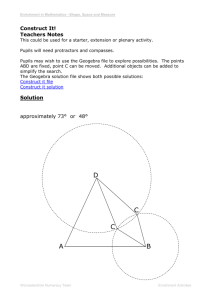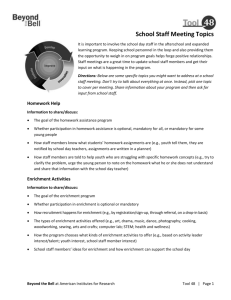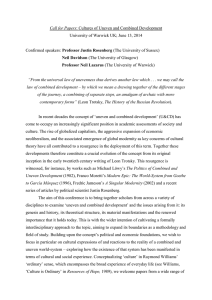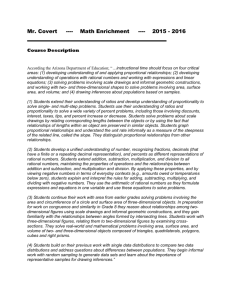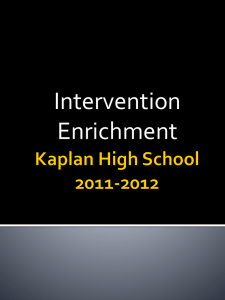Implementing PE Curriculum
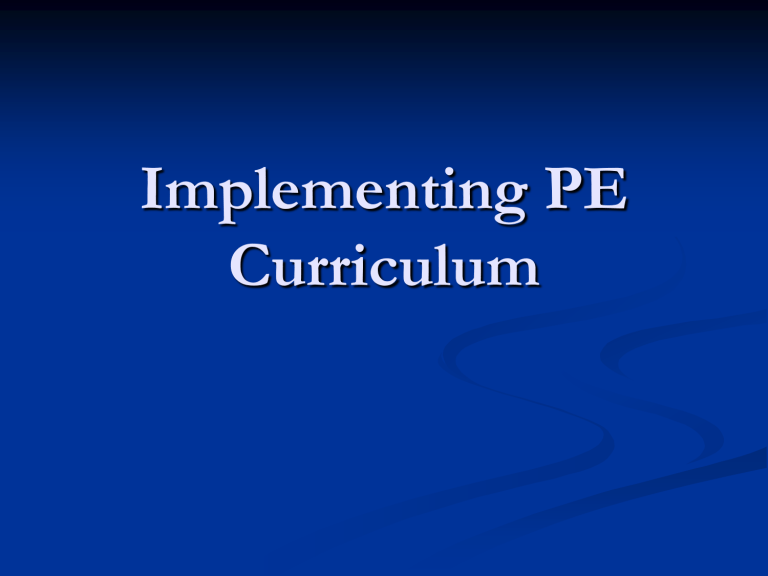
Implementing PE
Curriculum
Lesson Planning and the Curriculum
A well organized and practically based curriculum makes lesson planning easier. The curriculum should:
Identify the major learning objective for each lesson
Unify instruction across teachers and schools
Makes switching schools less problematic
Lesson Planning and the Curriculum
Avoid curriculums which look like this:
Maximizing Learning & Effective
Teaching
Motivation
Show enthusiasm, set high expectations (beware expectancy and self-fulfilling prophecy)
Provide remediation and enrichment
What are some examples?
Maximizing Learning & Effective
Teaching
Motivational Strategies
Meaningful activities
Developmentally appropriate activities
Grades/assessment
Reward structures
Reasonably high expectations
High success rates
Lessen fear of embarrassment (teaching by invitation, intratask variation, task sheets, stations, “extra PE” time
Obstacles to
Curriculum
Implementation
Brainstorm a list of four potential obstacles and be able to explore a solution for at least two of them.
Budget – sponsorships, grants, document equipment needs/purchases, make your own,
Parent/community support – newsletter, sport/family night, health status
Improve test scores – setting goals, enrichment, emphasize throughout or periodically, fall/spring retest for improvement
Brainstorm a list of four potential obstacles and be able to explore a solution for at least two of them.
Time – set aside time, maximize time you do have, make clear to admin that “taking” PE class should be a last resort, having a quality program is the best buffer, enrichment, intramurals
Transient students – enrichment, peer helper
Facilities – creative, utilize all possible teaching spaces,
Repetition – pairing like activities, staying current with new activities
Colleagues (MS, HS)
Can only deviate so far from the norm of the department.
If you find yourself in a substandard program, create the best classes you can in the context provided. However, in time, you can elevate a program through your example and persuasion of colleagues.
DO NOT belittle your colleagues or try and make too many changes too quickly.
One nice attribute of elementary PE is more autonomy.
Avg
Administration
Many are “jaded” by their experiences in “gym”
Important to educate them about the new PE, your goals, your instructional techniques. The more they know about quality programming, the better.
Administrators can eliminate or reduce time in PE
CT mandates
Under duress from No Child Left Behind, budget, parents…all corners. Often PE is in the back of their minds.
IMPORTANT to educate admin about PE and press for more time and more funding.
What are some ways to educate admin about PE?
Scheduling
In K-8 PE, classes are organized by grade level. In HS, PE is often the last class considered when creating the schedule. The result is:
Uneven number of students in classes
Uneven number of classes per period
Uneven distribution of grade levels (destroys vertical alignment)
Developmentally uneven proficiency levels (cog, psym, aff).
HUGE PROBLEM
Communicate with guidance department or whoever schedules to address the needs of PE.
Best case: Students pick activities/levels like in college
Good case: Classes organized by grade level
Needs improvement: classes organized by multiple grades (9-10, 11-12)
Worst case: All grade levels thrown into one class.
Lack of accountability
Supervision of PE is usually undertaken by:
administration who lack understanding of quality PE
department chairpersons who have the knowledge but lack the authority
No one – everyone does their own thing
Ideally a district supervisor an involved HPE & athletics director oversees PE, but this is usually not the case.
Such individuals have the knowledge and the authority to require quality instruction, professional development, adherence to the curriculum, and program improvement.
If you become a department chairperson responsible for a PE program, the amount of authority you have depends upon you.
Rapport, persuasion, & example are your most powerful tools.
Can hold district/department meetings, improve the curriculum, suggest instructional changes.
Poorly designed curriculum
Too many units
Not representative of the interests and motivations of students.
If students do not want to participate, are bored, and don’t take class seriously, that is the fault of the teachers and program.
PE class should offer something for everyone, especially the atrisk students.
Who is at risk?
Autonomy
Each teacher does “there own thing”
It is important teachers collaborate to offer the best curriculum possible.
Teachers working collectively can offer a more comprehensive and engaging curriculum than those working separately.
No assessment
Remember, the curriculum cycle is plan, teach, AND assess.
Not having assessments and accountability promotes the idea that PE is about recreation and not real learning.
AN effective teacher gets results (cog, psychomotor, affective).
Students will oppose assessment by pressuring teachers to simplify the curriculum, assign low-demand activities, and reduce evaluation – resist this.
Every activity of a school is undertaken for what?
Students
To prepare them for success as adults.
Teachers have a responsibility to STUDENTS, to offer the best programming and education possible.
